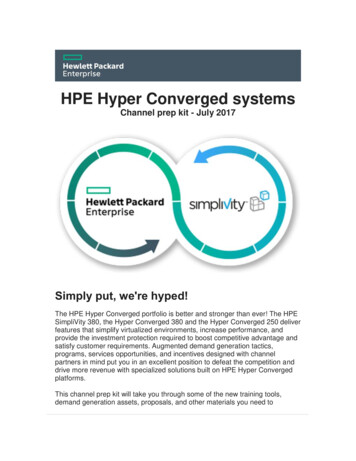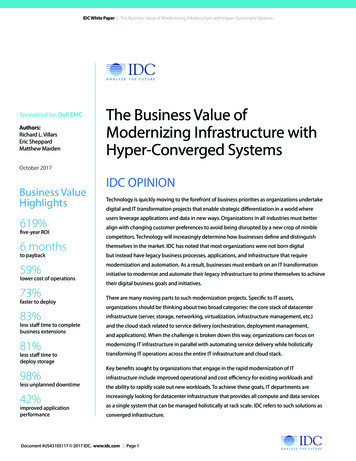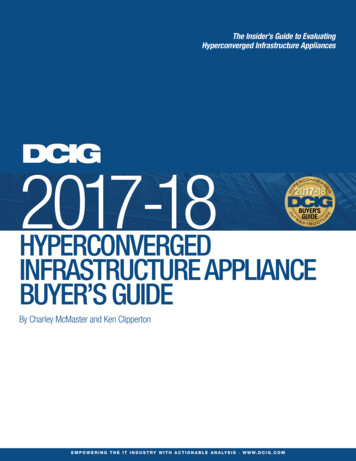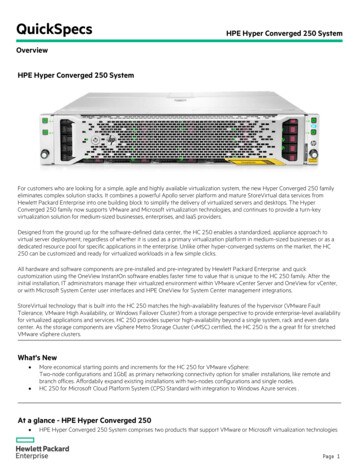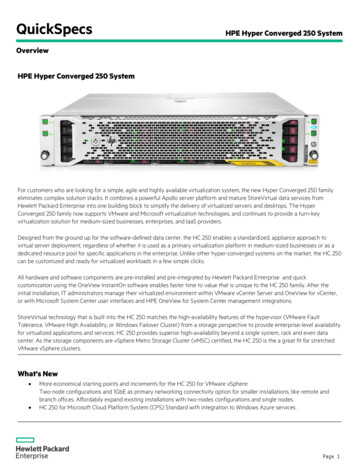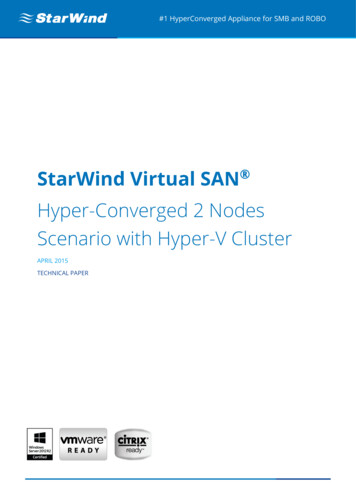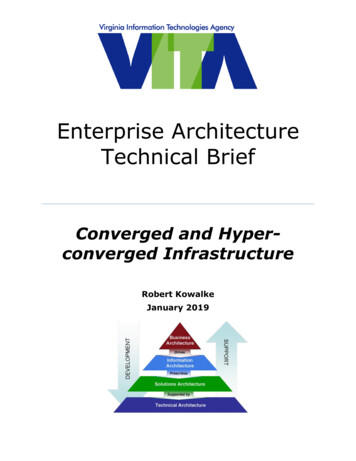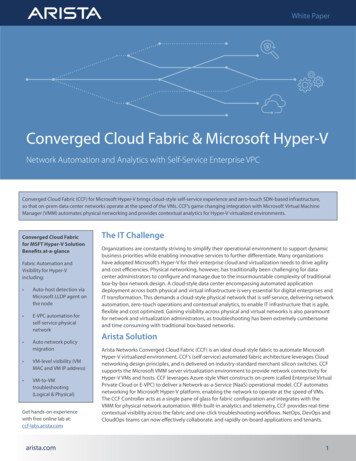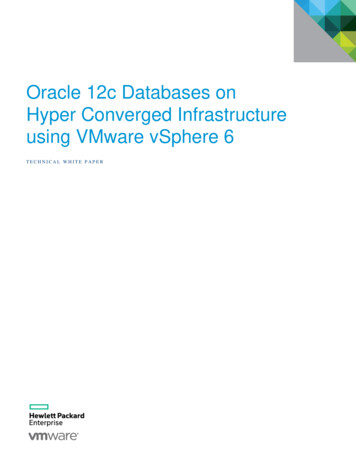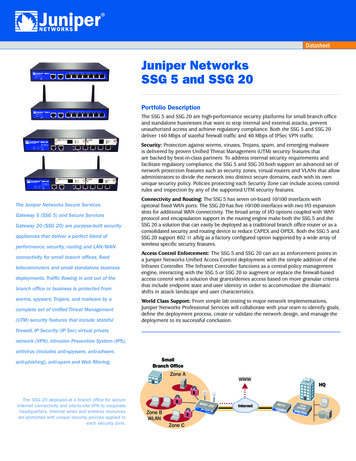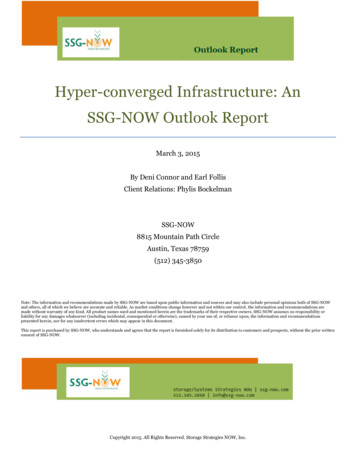
Transcription
Hyper-converged Infrastructure: AnSSG-NOW Outlook ReportMarch 3, 2015By Deni Connor and Earl FollisClient Relations: Phylis BockelmanSSG-NOW8815 Mountain Path CircleAustin, Texas 78759(512) 345-3850Note: The information and recommendations made by SSG-NOW are based upon public information and sources and may also include personal opinions both of SSG-NOWand others, all of which we believe are accurate and reliable. As market conditions change however and not within our control, the information and recommendations aremade without warranty of any kind. All product names used and mentioned herein are the trademarks of their respective owners. SSG-NOW assumes no responsibility orliability for any damages whatsoever (including incidental, consequential or otherwise), caused by your use of, or reliance upon, the information and recommendationspresented herein, nor for any inadvertent errors which may appear in this document.This report is purchased by SSG-NOW, who understands and agrees that the report is furnished solely for its distribution to customers and prospects, without the prior writtenconsent of SSG-NOW.Copyright 2015. All Rights Reserved. Storage Strategies NOW, Inc.
Table of ContentsTable of Contents . 2Editor’s Note .5Executive Summary . 6Driving Issues, Trends, History .7The history of Hyper-Converged Systems (HCS) .7How HCS differs from converged systems .7Benefits of converged compute and storage workloads on single hardware platform .7Private cloud and hybrid cloud use . 8Remote and branch office integration . 8Data Center Consolidation . 8Enablement of analytics . 8Hyper-converged Infrastructure Features . 9Hyper-Convergence on Industry-Standard x86 Platforms . 9Software-defined . 9Hypervisor Support.10Automation and Analytics . 11Maintaining State Information . 11Private and Public Cloud Integration . 12Resilience and Supportability . 12Centralized systems and network management . 12Support of Dissimilar Hardware Configurations . 13Distributed Systems Integration . 13Use Cases for Hyper-converged Systems . 14Postponing Capital Investment . 14Incremental growth . 14Public and Private Cloud . 14Specific Use Cases . 15Best Practices for the Implementation of Hyper-converged Systems . 16Use Case Profile. 17Sphere 3D . 19The V3 VDI Platform . 19Copyright 2015. All Rights Reserved. Storage Strategies NOW, Inc.
The Hyper-converged Appliances . 19Desktop Cloud Orchestrator. 20Optimized Desktop Allocation . 21Simplified Pool Orchestration . 22SSG-NOW’s Take on Hyper-Converged Systems . 23Copyright 2015. All Rights Reserved. Storage Strategies NOW, Inc.
SponsorCopyright 2015. All Rights Reserved. Storage Strategies NOW, Inc.
Editor’s NoteThis report on Hyper-converged Infrastructure was undertaken because there was so much noise in the industry as towhat hyper-converged infrastructures are. Industry analysts, vendors and end-user IT professionals all have theirown definitions. For some, Hyper-converged Infrastructures are just an extension of Integrated Infrastructure Systems.For others, it has everything to do with Web-scale computing practiced by the Amazon’s and Google’s of this world. Stillfor others, it is a type of computing system envisioned by VMware in its recently announced EVO: RAIL architecture.Those are a bunch of words that say a lot, but which provide little guidance to an IT professional or CIO that is faced withcrushing system and storage challenges in implementing a hyper-converged infrastructure.SSG-NOW is pleased to present this report on our definition of hyper-converged infrastructures. Read it with interestand if you have any questions, please contact us at the addresses below.Deni ConnorFounding Analystdconnor@ssg-now.comEarl FollisSenior Analystefollis@ssg-now.comCopyright 2015. All Rights Reserved. Storage Strategies NOW, Inc.
Executive SummaryHyper-converged systems first appeared in the data centers of the world’s largest Web-scale companies becauseorganizations such as Facebook and Google found that traditional storage architectures could not scale efficientlyand required high, recurring capital investments and increasing operating expenses. In addition, in order to support therapid expansion of infrastructure associated with Web-scale services, it was not efficient to relegate servers to dedicatedroles, but far better to have the same physical server capable of running both compute and storage workloads. Further, aclustered architecture was deployed in order to maximize availability and resiliency.The Web-scale companies recognized the importance of these features and spent the resources on the requireddevelopment of proprietary software as a core competency. Mimicking these innovations, a new crop of commercial hyperconverged systems have begun to enter the market with the promise of providing mainstream IT the same advantages ofscalability and low incremental growth costs, with total cost of ownership less than more rigid, conventional architecturesof dedicated compute farms and proprietary shared storage systems.SSG-NOW was an early researcher in this new field and has initiated coverage of converged compute and storagefunctions as a high-growth product category. By using industry-standard x86 hardware platforms that include directattached storage rather than purpose-built and proprietary storage systems, capital expenditures and operating expensescan be minimized. The requirements for the software to operate compute workloads and storage on the same hardwareinclude functions that are integrated with virtualization hypervisors and operating systems, while supporting both solidstate and rotating storage media.Organizations of all sizes have benefited from hyper-converged systems as a solution to sprawling server farms,expensive and poor scalability of shared storage systems and a seamless method to integrate multiple sites and hybridcloud uses.Copyright 2015. All Rights Reserved. Storage Strategies NOW, Inc.
Driving Issues, Trends, HistoryThe hyper-converged systems of today are a combination of years of development and refinement of virtualizationsoftware and similar advances in hardware. The popularity of hyper-converged systems can also be attributed toadvances in scalable, modular computing hardware and software concepts pioneered by Google, Facebook and other Webscale companies. Similar advancements in software-defined computing also contribute to the striking potential of hyperconverged systems to fundamentally change the way we build-out, operate and maintain modern enterprise data centers.The history of Hyper-Converged Systems (HCS)The roots of hyper-converged computing are based in advances in virtualization and the physical shrinking of datacenter hardware. Converged systems, such as the HP ConvergedSystem and IBM PureSystem, for high-density datacenters was the first step in the HCS odyssey. Web-scale companies then took that concept several steps further bydesigning, building and deploying hyper-converged systems in very dense deployments. Google was a pioneer in the areaof their modular data centers built from shipping containers containing racks of hyper-converged systems. This ideacarries the modular characteristics of HCS to the next level, as those shipping containers can also be stacked and quicklyconnected to a data center network, creating large-scale modular computing environments based on small-scale modularcomputing systems.How HCS differs from converged systemsHyper-converged systems grew out of the market movement for converged systems, which features individualcomponents specifically designed to interoperate seamlessly. HCS takes that idea to the next level by combining thoseindividual components into a single chassis, allowing for even tighter integration between the storage, compute, networkand management software. The results is a modular data center building block, with each hyper-converged system able tobe deployed and configured very quickly. Some HCS vendors offer to load disk images and pre-configure the hyperconverged system so that it can literally be slid into a rack, plugged into power and network outlets, turned on and beoperating very quickly. These are the primary advantages that HCS has over converged systems: speed of deployment,ease of installation and rapid utility.Benefits of converged compute and storage workloads on single hardware platformThe primary benefits of HCS reside in the ease and speed of deployment, the modular nature of HCS and the tightintegration of converged components offered by HCS right out of the box. This concept reduces the need to spend timedesigning effective, compatible, yet separate data center systems. If you need more compute or storage capacity, yousimply deploy additional HCS compute or storage nodes as needed. Because all of the hardware and software has beendesigned from the ground up to work in unison and all come from a single vendor, support costs are notably lower, as arethe opportunities for vendors to point the finger at each other when issues arise. With HCS, you have a single vendor neckto wring if problems crop up.Copyright 2015. All Rights Reserved. Storage Strategies NOW, Inc.
Private cloud and hybrid cloud useA driver for the wide-spread acceptance of the hyper-converged architecture is the ability for companies to easily andquickly utilize HCS for private cloud and hybrid cloud deployments. As many enterprise companies are just beginning toexperiment with private cloud and hybrid cloud data centers, HCS is a natural fit in those environments. Considering thatmost public cloud companies are using HCS as their building blocks, enterprises looking to replicate that public cloudfunctionality in a private or hybrid makes perfect sense.Remote and branch office integrationAnother potential sweet-spot for HCS is in remote and branch office installations. Many companies find itadvantageous to deploy certain server components to physically remote locations to reduce wide-area network expenseswhile also offering better application performance to end-users at remote offices. Email server, database servers andhighly-utilized applications can all benefit from locating those computing resource as close as possible to end-users.Hyper-converged systems fit the bill perfectly due to the ease at which those systems can be deployed and supported.Data Center ConsolidationBecause of the high density of large HCS deployments, special attention must be given to power, cooling andnetworking in data centers utilizing HCS. The miniaturization of HCS hardware components means that racks of hyperconverged systems are extremely dense and may require increased cooling, high-amperage electrical circuits and highspeed networking within and between racks. Also, remember that increasing electrical circuit density will have an impacton backup generators and fail-over cooling strategies employed by that data center.Enablement of analyticsOne of the challenges in systems management and monitoring has always been the aggregation and correlation of keymetrics collected from a multitude of underlying devices, network links and storage systems. HCS offers a plethora oftightly integrated data from the various components contained in the HCS chassis. Also, note that management software isa key component of HCS, giving HCS vendors the ability to deliver comprehensive management and monitoringcapabilities that can contribute valuable data to be used in analytics and predictive analysis.Copyright 2015. All Rights Reserved. Storage Strategies NOW, Inc.
Hyper-converged Infrastructure FeaturesThere are many features that are requisite of hyper-converged systems. Among them are being based on industrystandard x86 platforms, hypervisor-dependence or hypervisor-agnostic, distributed architecture, centralizedmanagement, both storage and compute capabilities in a single system, and enhanced scalability.Hyper-Convergence on Industry-Standard x86 PlatformsA key concept in delivering high-performance data centers is the best practice of locating storage in close proximity toactual application workloads. Hyper-converged systems achieve that performance efficiency by integrating scalablecompute and storage capabilities in the same physical chassis. (Note that there are industry-standard x86 platforms on themarket that do not qualify as hyper-converged systems because they do not contain storage and compute capabilities in asingle chassis.) In the example of clustered, hyper-converged servers, all direct attached storage nodes within a servercluster are aggregated together into a shared pool of storage that can be accessed by any server within that cluster. Thisdesign keeps latency and complexity to a minimum, compared to traditional hardware-based shared storage schemes,while still supporting virtualization features that require shared storage. The hyper-converged architecture seamlesslysupports both hard disk drives and Flash drives that can be managed and monitored via virtualized storage controller.This controller directly ties shared storage resources to I/O requests generated by the hypervisor, thus eliminating themismatch between compute and storage (often called ‘the I/O blender effect’). By building-in robust error detection andautomatic recovery resources, hyper-converged computing provides a high availability, fault-tolerant computing platform.These techniques are critical to the performance and resiliency of the virtualized storage subsystem that support highlyavailable, hyper-converged computing.Software-definedThe concept of software-defined computing -- including networking, storage, and compute -- is key to effectivemanagement of large-scale hyper-converged data centers. Software-defined computing utilizes inexpensive, industrystandard hardware -- servers, network devices and storage systems -- rather than dedicated, proprietary hardware onwhich servers, networking and storage technology has always relied. By logically detaching the software from underlyinghardware, hyper-converged systems are able to evolve and support new hardware components far faster and cheaper thantraditional proprietary computing hardware. Software-defined computing gives vendors and customers the ability toquickly take advantage of ongoing developments in memory, storage and processor upgrades. Because of software-definedcomputing, customers and vendors no longer have to wait for an OEM firmware update or an update to device operatingsystems in order to take advantage of new hardware capabilities. Traditional hardware-defined solutions rely on dedicatedCopyright 2015. All Rights Reserved. Storage Strategies NOW, Inc.
firmware and software that must be thoroughly engineered and tested prior to releasing new features and capabilities, aprocess that can take months or even years in some cases.Hypervisor SupportThere are two types of hyper-converged systems: those that are hypervisor-agnostic, i.e., they can operate on two ormore different hypervisor platforms, and those that are hypervisor-specific, i.e., they run on only one or two of the majorhypervisor platforms. At first glance, it might appear that a hypervisor-agnostic hyper-converged system has anadvantage because it runs on multiple of the popular hypervisors platforms. And, certainly, if you are implementing ahyper-converged system in an environment that runs two or more hypervisors, there may be a justification for choosing ahypervisor-agnostic system. However, there are advantages to choosing a hypervisor-specific hyper-converged system,including tighter integration with the underlying hypervisor, the possibility of increased performance -- the extra coderequired to run on multiple hypervisor platforms may adversely affect performance -- plus a tighter integration with andincreased functionality from within the underlying hypervisor management and administrative tools. There is no onecorrect answer for choosing between hypervisor-agnostic and hypervisor-specific hyper-converged systems. There areadvantages and (minor) disadvantages to each approach and the final decision should be weighed carefully prior topurchasing and implementing a hyper-converged solution.Data Placement, Latency and Intelligent TieringAs mentioned above, keeping your application data in close physical proximity to the application server itself is a bestpractice for hyper-converged environments. This approach minimizes latency and keeps network traffic to a minimumcompared to traditional compute and storage architectures. Gone are days of hugely expensive dedicated tiers of serversand physical storage arrays. However, the concept of keeping data as close as possible to the application is complicated bythe fact that virtual machines (VMs) can and will migrate from one physical hypervisor host to another. When VMs move,the underlying application data must also move to the new hypervisor host. Failure to do so can have a significant impacton storage -- and thus application -- performance as data must traverse more of the data center network as needed by theapplication. The type of storage media used can also improve latency. Flash storage devices offer much better performancethan do traditional hard disk drives. In high-performance architectures, Flash storage should be reserved for the mostfrequently used data, while less time-critical data can be relegated to slower storage media.Linear ScalabilityScalability is also a critical consideration for hyper-converged environments, as application data utilization tends toincrease over time. Traditional hardware-based storage systems require ample budget to procure and sufficient time todeploy well in advance of the application storage use curve. Building out your hardware-based storage today so that you'llbe ready to handle increased storage utilization in the future is an expensive and wasteful approach, as you are frequentlyCopyright 2015. All Rights Reserved. Storage Strategies NOW, Inc.
provisioning unused storage capacity months or even years before that capacity will be put to use. Not only is thisapproach expensive and wasteful, but it also limits data elasticity as application and business requirements change overtime. The ability to scale storage capacity up or down at the hyper-converged server level provides a lower-cost, elasticmodel for rapidly adjusting storage capacity as needed. The expansion or retraction of storage limits over-provisioning orunder-provisioning storage while reducing storage costs. With this fact in mind, customers are encouraged to carefullyselect a hyper-converged platform that does not limit storage scalability by server or storage nodes.Automation and AnalyticsThe old saying that you can't manage what you can't measure is especially true in the world of hyper-convergence. Asthe number of nodes in a physical cluster increase, there is a corresponding increase in the complexity of managing andmonitoring storage nodes. Increasing complexity implies a higher level of effort to effectively manage that physicalstorage. The hyper-converged, software-defined data center leverages a high level of automation to avoid the error-fraughtmanual activities related to administering storage systems. With the automation offered by hyper-converged systems,administrative tasks can be reduced to troubleshooting tactical issues and deploying new workloads. Automation reducesoperating costs by requiring less human intervention. Automation capabilities can also leverage predictive analytics toproactively identify trends and demand fluctuations that might lead to resource contention or wasted computingresources. Predictive analysis supports the ability to address and correct impending issues before they can affectapplication or infrastructure performance and availability, thus reducing downtime and saving money.Native Data ManagementTraditional physical storage systems include sophisticated data management algorithms that ensure data protectionand recovery capabilities. Typical data management features include taking data snapshots, cloning workloads and serversand transporting data to remote storage environments to ensure disaster recovery requirements. These data managementtechniques can be generated via automation policies or via a manual process. The downside of these data managementtechniques is that they can negatively impact network bandwidth utilization, while also creating duplicate copies of datasets or large blocks of unused storage space. Hyper-converged, virtualized systems can automate these day-to-day datamanagement chores while presenting admins with a unified view of storage, whether local, remote, or virtualized. Hyperconverged systems can also automate the backup, archiving and disaster recovery process, so be sure that the hyperconverged platform you choose supports automation of data management.Maintaining State InformationThe design of massively scalable storage requires each node to manage a subset of the storage state information, nomatter how many nodes reside in the storage cluster. This design goal requires storage clusters to distribute stateCopyright 2015. All Rights Reserved. Storage Strategies NOW, Inc.
information among all nodes, not storing it in a single, centralized state repository. This de-centralized state informationis a key requirement of scalable hyper-converged systems, yet centralized state information is almost impossible to retrofitinto legacy storage architectures. Centralized state information eventually creates so much inter-nodal traffic that it cansaturate network links between nodes. Hyper-converged infrastructure solves this problem by continuously synchronizingstate information among the nodes, so that the failure of one node has no lasting effect on the redundant state informationresiding on the other nodes.Private and Public Cloud IntegrationSSG-NOW conducts annual surveys to gather real-world data on utilization of cloud storage and hyper-convergedstorage systems. One survey reinforces the view that public cloud utilization is in high demand as an extension of datacenter infrastructure for many enterprises. Fortunately, most hyper-converged solutions support autonomousparticipation with public, private, and hybrid cloud scenarios. Seamless integration with cloud resources and the ability tomanage workloads from a central location, regardless of where those workloads run, is a key competitive advantage ofhyper-converged systems. The most frequently cited example is the use of public clouds for data backup, archiving anddisaster recovery. Policy-based automation can take incremental snapshots at given intervals in order to supportorganizational recovery time and recovery point objectives.Resilience and SupportabilityAutonomous self-repair, fault tolerance, and supportability have been design goals of infrastructure componentssince the first cave-man suffered a hard drive crash with no viable recovery plan. Hardware and software vendors haveworked for years to bring this idea to fruition, with varying results. Fault tolerance and resilience is critical because nohardware lasts forever. Hardware-based outages occur with regularity in the modern data center so having a plan in placeto address critical failures is of paramount importance. For instance, the ongoing update process for firmware andsoftware revisions must be optimized to minimize downtime. Ideally, a hyper-converged system should be able todownload and install software updates with no impact or interruption to production applications. Compute and storagenodes should be able to be added or removed from the network and workloads redistributed without disruption. Be sure toconsider resilience and supportability when evaluating hyper-converged systems.Centralized systems and network managementEffective, intuitive systems, storage and network management capabilities can make the difference between smoothoperations and a hobbled hyper-converged system implementation that stymies administrator’s efforts to keep everythingrunning as expected. Do not underestimate the need for effective, intuitive management capabilities in your hyperconverged environment. With that in mind, the hyper-converged management console is a key factor to evaluate whenconsidering implementing a hyper-converged environment. The evolution of the skill sets required for the admins ofhyper-converged systems dictates that ease-of-use is of utmost concern in hyper-converged management capabilities.Copyright 2015. All Rights Reserved. Storage Strategies NOW, Inc.
Using examples of the iPhone interface or game console interfaces, that same idea of a clear-cut, concise management userinterface is the goal. In contrast to management interfaces for legacy components, the hyper-converged managementconsole should cater to the fact that the admin using that console may have a strong background in servers,
The history of Hyper-Converged Systems (HCS) The roots of hyper-converged computing are based in advances in virtualization and the physical shrinking of data center hardware. Converged systems, such as the HP ConvergedSystem and IBM PureSystem, for high-density data centers was the first step in the HCS odyssey.

